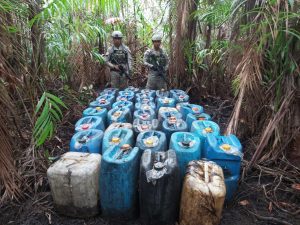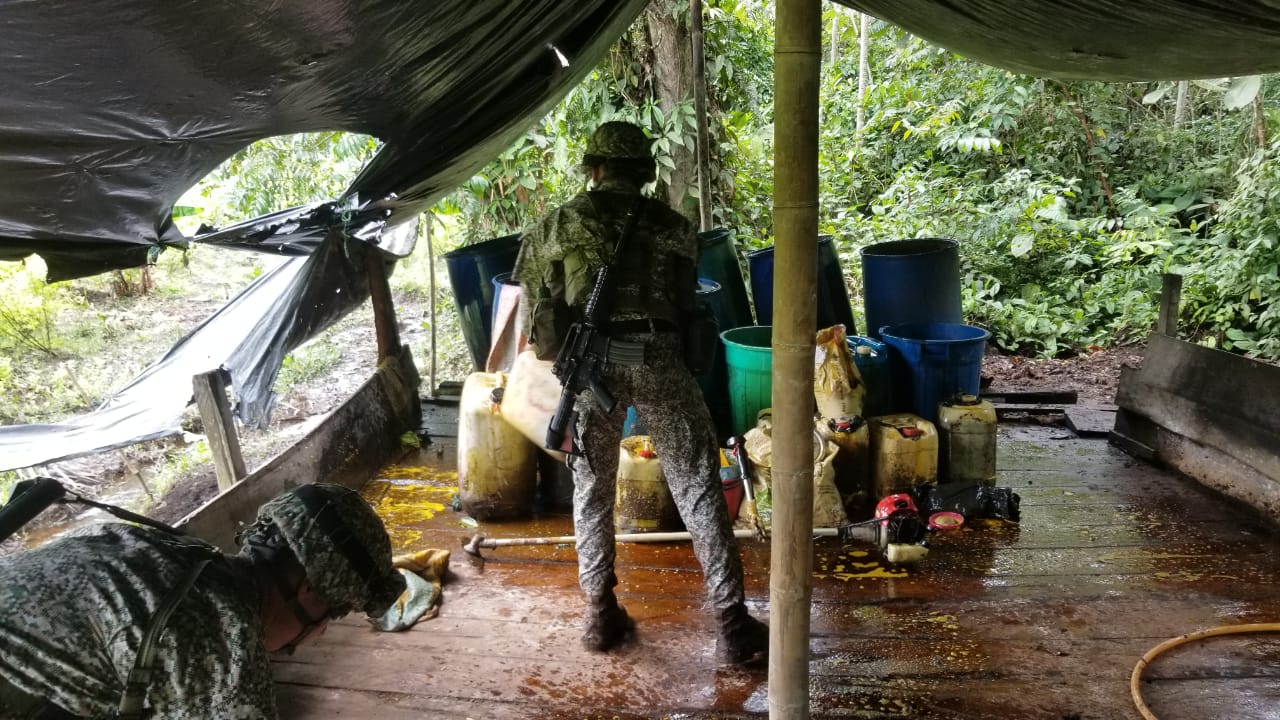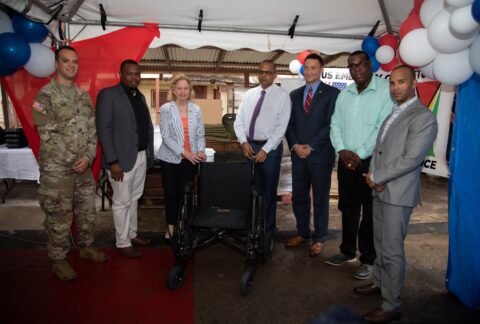In late April, the Military Forces of Colombia, with support from the Office of the Attorney General’s Technical Investigation Corps and the United States, found a large complex for the production of cocaine in a rural area of Nariño department, in the Pacific coast of Colombia. The complex, consisting of eight structures scattered over a 1 square-kilometer area in the San Sebastián district, Tumaco municipality, had the capacity to produce 6 tons of drugs monthly.
During the operations, troops from the Pacific Naval Force’s 4th Marine Corps Brigade and the Army’s Counternarcotics Brigade dismantled a solid and liquid materials warehouse, laboratories to process coca base paste, and a crystallization plant for cocaine hydrochloride, said the Navy in a press release.

“Service members found more than 4.3 tons of solid materials and 3,575 gallons of liquid materials in the complex, as well as 390 gallons of coca base paste in process and more than 1 ton of cocaine hydrochloride,” Colombian Minister of Defense Carlos Holmes Trujillo said on Twitter.
According to the Navy, the organized armed group United Guerrillas of the Pacific, a dissident group of the Revolutionary Armed Forces of Colombia, operated the complex — the largest found so far in 2020.
The Military Forces have dismantled 29 narcotrafficking facilities and seized more than 50 tons of cocaine in the Colombian Pacific from January to mid-May 2020, said the Pacific Naval Force. According to the U.S. Department of State’s 2020 International Narcotics Control Strategy Report, the Colombian Armed Forces destroyed more than 4,200 cocaine labs and seized about 378 tons of cocaine nationwide in 2019.
The operation
“The operation began after we received naval intelligence indicating that there was a cocaine hydrochloride production center in the general area of the San Sebastián district,” Colombian Navy Rear Admiral Hernando Enrique Mattos Dager, commander of the Tumaco-based 72nd Poseidón Task Force against Narcotrafficking, told Diálogo. “During the planning process, conducted with the Counternarcotics Brigade, we had the support of the DEA [U.S. Drug Enforcement Administration], which provided us information about the area through satellite photos, which helped us do the planning.”
With the information gathered, the military troops left Tumaco to carry out reconnaissance of the area. In four days, the units deactivated 19 grenades and two cylinders loaded with 35 kilograms of explosives before locating the structures, the Navy reported.
During reconnaissance activities, service members captured five armed individuals who were guarding the area and rescued two minors who also helped to alert the narcotraffickers, Colombian Navy Colonel Nelson Ahumada Ojeda, commander of the 4th Marine Corps Brigade, told Diálogo.
“One of the key outcomes of discovering this mega crystallization plant is that we prevented 6 tons of cocaine hydrochloride from being commercialized in U.S. and Central American markets,” Rear Adm. Mattos said. “This represents a loss of about $198 million for the illegal organization.”
“What is complex about this operation is seeing how narcotrafficking is able to build this kind of structure in such a remote place, and secondly, seeing the forest and environmental damage that narcotrafficking activities cause,” Col. Ahumada concluded. “We also found that many of the people who work in those areas do not get paid; at this point, they are essentially working to be able to consume psychoactive substances.”








